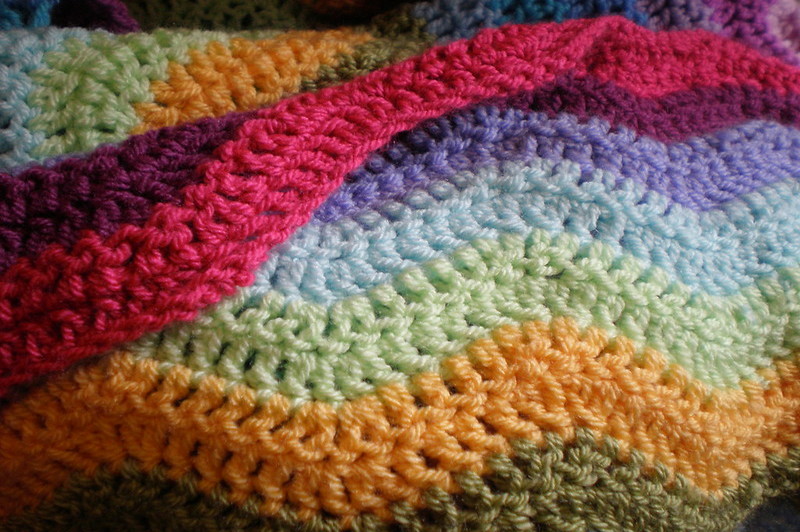By owning one for some time, you’d know that it’s important to know how to make a crochet blanket soft, and it takes only four steps.

Unlike common fabrics, wool and other crocheting yarns suffer from stiffening with time and get deformed just from washing.
Crochet blankets are catching up on-trend as they are comfy, picture-perfect, and just fun to make.
Many young adults are getting interested in making these blankets that search engines are swelling with articles on how to crochet your blanket.
You might have seen some of these articles and have created one for yourself.
If you have created one yourself, you might’ve noticed that maintaining your blanket’s perfect look is different from the typical washing and drying for other fabrics.
Crochet blanket’s texture is noticeably different and requires a different treatment.
Let’s talk about how you can condition your blanket back to its original state!
Steps On How To Make A Crochet Blanket Soft
Most people would tell you that it’s enough to just wash and dry your crochet blanket.
However, you would easily see that if you stick to just washing, the blanket’s look deteriorates faster until it becomes a big lump of cloth that you wouldn’t want to use anymore.
Here, we’ll share some easy steps of how you can prolong your blanket’s charm.
Step #1. Classify and cover up your blanket
The first step is all about preparing your blanket for the process.
Some crochet yarns tend to bleed when they come into contact with water or detergent, though it only occurs to a very few of them, especially the ones from thrift shops.
You can crochet beautiful pieces from cheap yarns as long as you check their manufacturer’s guide.
To avoid getting your blankets suffering from bleed-outs or discoloration, classify them according to color before softening, especially if you have many blankets to work on.
Place them in separate cloth bags for easy identification, then work on them by batch. Working by batch will also allow you some leeway to rest in between them.
If you have only one blanket to condition, then you can work on it directly.
Step #2. Dip the blanket on cold water
Whether your blanket came from washing or if it’s already dry, it’s best to let it soak up some water before you introduce it into a softener.
Leave your blanket on the basin of cold water for at least twenty minutes.
If you have available vinegar, you can add around one tablespoon for every three gallons of water for additional softening.
Once you finish soaking the blanket, rinse it with clean water if you added vinegar. Squeeze the water out but avoid wringing your blanket.
Step #3. Shampoo the entire blanket
Yes, you need to put shampoo on your blanket. It will clean your blanket, help in untangling undesirable knots, and allow the yarn to shine afterwards.
There should be some list about washing instructions on the tag of your yarn or blanket. We recommend using mild shampoo on old and new blankets.
You are free to decide on how much shampoo you’re going to use, as long as it’s not too concentrated and is properly proportioned to the size of your blanket.
Mix the shampoo to a basin of water, enough to soak the entire blanket. Gently hand wash your blanket through the mixture, squeeze and rinse afterwards.
Step #4: Soak the blanket on a fabric conditioner
After you’ve rinsed all the shampoo bubbles off, you can now use fabric conditioner.
Fill your basin or sink with enough water to soak the entire blanket and mix the fabric conditioner there.
Avoid pouring too much of the conditioner there since the best result is something you’ll get from following the manufacturer’s instructions.
Most fabric conditioners are also laced with perfume, and creating a thick mixture will end up making your blanket smell too strong.
Once you’ve finished mixing, transfer the blanket to your mixture and let it stay there for an hour.
After which, you can optionally rinse it before drying, or if you want, you can dry it with the softener on.
What causes crochet blankets to get scratchy and stiff?
There are innate and created reasons as to why your crochet blanket ends up stiff and scratchy.
One of these reasons occurs before you even buy the yarn or the blanket itself: that is, the material used to create the yarn skeins are rough and stiff to begin with.
Stiffness can usually be observed on fibers which give them strength against getting tugged off.
Another reason for stiffness would be your crochet techniques. A crochet project can get a bit rigid if you keep tugging too much on the threads while you’re making it.
The same thing can occur if you use the wrong size of thread for your hook.
Some washing residues or the collected suds during cleaning that got stuck and ironed to your blanket can also end up making it stiff.
Most of the reasons for stiffness, however, can be addressed by conditioning. This is why you should soften your crochet blanket at least once every two weeks.
Conclusion
It’s convenient to learn how to make a crochet blanket soft, especially if you own many of these blankets.
Maintaining them beyond just regular washing and proper storing can save you a lot compared to having to buy or make new ones.
After all, crochet can take some time to finish one blanket, but it’s heart-warming to use one that you took great care of by yourself.
